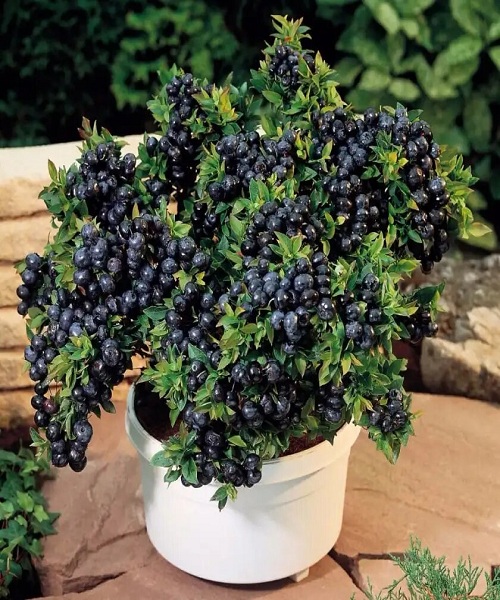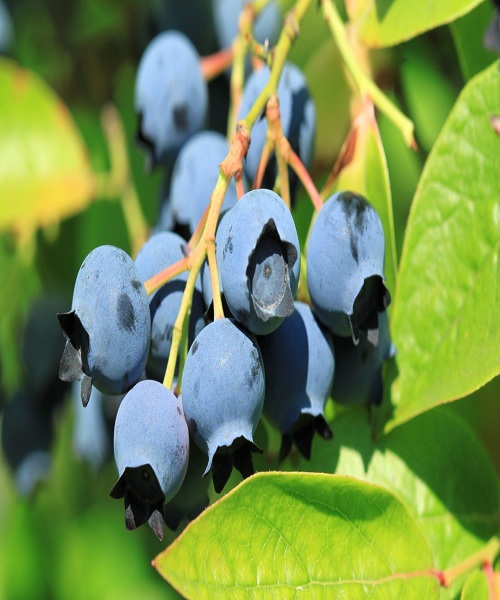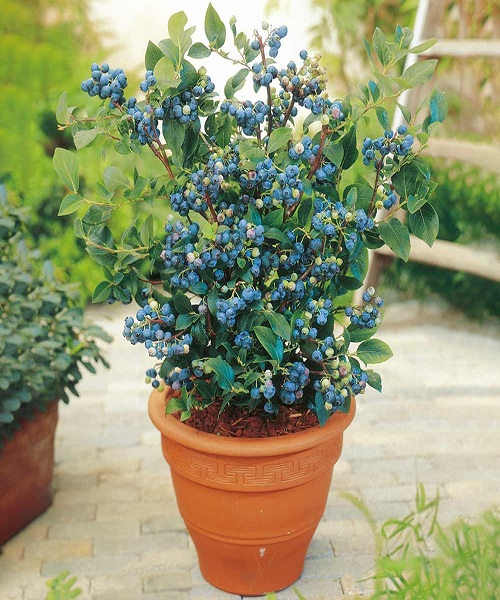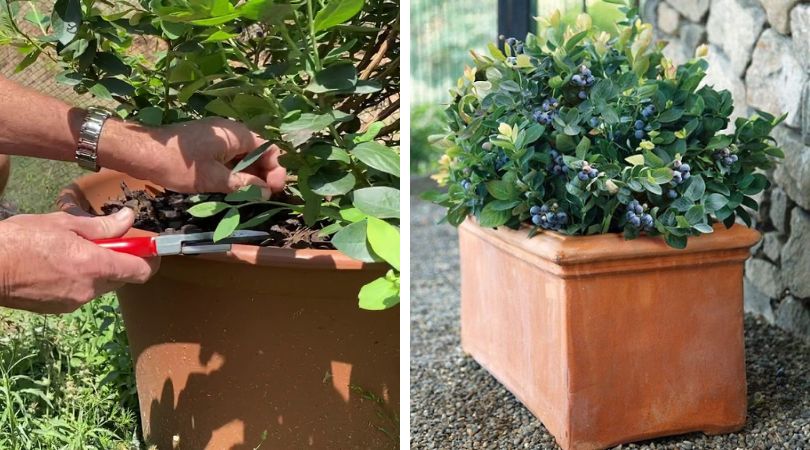Growing a wide variety of plants in containers is an excellent solution for anyone with a small yard, a small garden, or no yard at all.
In this post, we’ll look at how to produce blueberries in pots, one food crop that thrives well in containers.
Blueberries in Pots: What’s the Point?

Growing blueberries is a rewarding experience. They are packed with vitamins and antioxidants, making them an excellent source of nutrition.
They can be eaten right out of the bush, but they can also be cooked and used in a wide variety of dishes.
To top it all off, blueberries are aesthetically pleasing plants.
After the fruits have been gathered, the foliage’s fall colors provide a lot of interest to the bushes.
Isn’t it better to cultivate them in a garden or in a pot?
As it turns out, blueberries are ideal for this type of farming because they have specific wants and requirements.
Because of their preference for acidic soil, blueberries are frequently grown in containers.
Growing blueberries in pots is the best option unless you live in an area with acidic soil or can modify your soil suitably.
Because these plants are ericaceous (acid-loving), even if you have acid soil, you may discover that blueberries thrive in pots rather than on the ground.
It’s possible that you’ll run across a difficulty with damp or muddy land.
Blueberries prefer damp but not ‘paddling’ conditions. Blueberries may be harmed by water retention around their roots when cultivated in heavier, clayier soils.
You can usually get the damp yet free-draining conditions you need in a container.
How to Pick the Right Plant for Your Yard

The first step in growing blueberries in a pot is deciding on the type of blueberry you wish to plant.
To begin, let’s look at what plants we mean when we say “blueberries”:
What Is a Blueberry?
Blueberries belong to the genus Vaccinium and are perennial fruiting shrubs. Many diverse plant species in this genus are known as “blueberries,” and they all fall under the umbrella of the term.
A lot depends on where you live when it comes to the plants that go by this name.
It is crucial to know the plants we are referring to before delving further into which possibilities to grow.
Commercial blueberries in North America can be divided into two categories:
- Highbush blueberries (V. corymbosum), (from which most cultivated blueberries are derived
- Lowbush blueberries (V. angustifolium) (wild blueberries, which are occasionally also semi-managed or grown on a smaller scale).
Both wild blueberries with varying natural ranges and cultivars created for specific features, like as larger or more flavorful fruit, can be found in these two groups, and there are many distinct kinds of each.
Although blueberries were originally native to the north, cultivars have also been developed to grow in more southern states, where they can thrive.
If you’re in the Carolinas to the Gulf Coast states, you’ll find rabbiteye blueberries.
The Southern highbush blueberry cultivars are a result of crossing Northern Highbush blueberries with other southern-adapted Vaccinium species.
Huckleberries and whortleberries, two closely related plants, are also occasionally referred to as “blueberries” or sold in products like blueberry jam.
Commercially available American blueberries can be found all throughout the world, from Europe to Asia.
However, ‘blueberries’ can also refer to a variety of different species, including the ‘European blueberry’ or bilberry/blaeberry, which is the most common (V. myrtillus).
Commercially, these are rarely grown, but they can be in a small-scale or domestic setting if the conditions are favorable.
The berries are smaller, but some say they have a better flavor.
Choosing Container Blueberry Cultivars

The American highbush variety of blueberry is most commonly used for containers. In order to generate smaller plants, these are generally cultivated on a dwarfing rootstock.
If left unchecked, most highbush varieties will reach a mature height of 3 to 5 feet.
Dwarf blueberries are tiny and can only grow to a height of two feet.
If you wish to grow blueberries in pots, these are some of the most popular cultivars in the United States.
- Top Hat (zones 4-7).
- Sunshine Blue (zones 5-10).
- Pink Popcorn (zones 4-8) – This is an unusual option with pink berries.
- Pink Icing (zones 5-10).
- Bluecrop (zones 4-7) – This is the most popular blueberry variety in the world.
- Duke (zones 5-8).
- Spartan (zones 5-7).
There are, of course, countless additional cultivars to consider as well.
Please investigate different cultivars of blueberries if you are serious about cultivating blueberries.
As an added treat, you’ll get an additional blueberry plant in addition to the 500 seeds included in the kit.
It’s not simply the attributes of a certain variety that should influence your choice, but the location where you reside as well.
Keep in mind that not all blueberries are self-fertilizing. Pollination can be difficult if they don’t have a mate. Although blueberries are self-fertile, they often produce more fruit when planted with at least one other plant.
At least two or three blueberries should be grown in pots simultaneously for this reason.
In order to find plants that will thrive in your region and complement one another, ask the professionals at your local garden centre or plant nursery for advice or guidance.
When deciding which crops to cultivate, each type should be given a chance to speak.
You can significantly extend your harvest season by selecting an early, mid-season, and late cropping option.
When to Purchase Blueberry Plants
Blueberries that are grown in pots can be purchased year-round. You can also choose and order bare-root blueberries in the fall for putting out during the slumber period.
For the greatest results, you should buy your blueberries in the spring or fall, when their transfer to their new pots or containers will be less stressful.
How to Pick the Right Container
When it comes to choosing the correct plants, choosing the right container or containers is just as crucial.
In spite of their appearance, fresh-picked blueberries cannot be stored in the pot in which they were produced.
The pots that come with potted plants are often too tiny for the plants that have already outgrown them.
Planting blueberries in containers smaller than 30cm (12 inches) in diameter is appropriate for both young, pot grown and bare root varieties.
Your container should be at least 18 inches deep to get the greatest results.
Your pot or container should be at least 50cm (20 inches) in diameter when your plant has outgrown the 12-inch pot or if you have purchased a larger blueberry bush.
It’s a simple case of the bigger the better here.
When making your selection, keep in mind whether or not you’ll be rearranging the pots.
Options for Blueberry Containers

For your blueberries, there are many gorgeous pots to choose from. A sustainable lifestyle necessitates avoiding the use of plastics and composite resins whenever possible in the yard.
Fortunately, there are a number of pots that are not made of plastic that you can choose from. You could, for instance, go with:
- A big terracotta or ceramic pot.
- A wooden container for a plant.
- A metal container for plants.
If you wish to grow blueberries in pots, keep in mind that you don’t definitely need the containers.
Alternatively, you may try your hand at some upcycling. In many cases, reusing materials that might otherwise go to waste is a terrific strategy to expand your farmland. You could, for example:
- Use old 5-gallon buckets to grow blueberries.
- Make larger planters out of used 55-gallon barrels.
- You may construct your own planters out of used wood.
- Grow bags can be made out of potato sacks or similar materials.
- Grow your own blueberries in a repurposed sink or tub.
Construct certain your containers have enough drainage, regardless of whether you buy or make them.
To prevent waterlogging of the roots, drill holes in the bottom of pots, planters, and containers and fill them with crocks, rocks, or similar materials.
Preparation of the Growing Medium
Because blueberries are ericaceous, they require an acidic growth substrate. To avoid any issues, make sure that the soil/compost in your pots or containers has a pH of 5.5 or lower.
You can buy ericaceous compost, but you should opt for a peat-free kind that is better for the environment.
Acid-loving plants can benefit from generating their own compost.
When making compost at home, you’re usually aiming for a neutral pH, but you can make it more acidic by:
- Use a lot of pine needles, conifer bark, and wood chips to bulk up your pile.
- If possible, use leaf mould created from the leaves of oak and beech trees. In the Fagaceae family, beeches and oaks are both members. When degraded, their leaf can acidify the environment.
- Adding citrus fruits and other nitrogen-rich green kitchen scraps will acidify the compost.
Use a soil pH testing kit when you build your own ericaceous compost so that you can ensure that the pH is within acceptable ranges for your blueberries (or other ericaceous plants).
Planting Blueberries in Containers
As soon as your pots and growing media are ready as well as your blueberry plants, it’s time to get started planting!
Sprout pot-grown blueberries out of their pots and into the ground (if they are rather pot-bound, tease out the roots around the edges).
A small amount of your preferred growing medium should be placed in the base, followed by the placement of your bare root or pot-grown blueberries, keeping them upright and in the centre of the container.
Plants should be planted at the same depth as they were previously. To see where the earth came up to before, you should look at the plant’s bottom stems.
You may want to add some mycorrhizal fungi to your pots before filling in around the roots of your plants with your growing media for the best results. You can read Tracey’s whole article on mycorrhizae in the garden here. You’ve been missing out on incredible yields thanks to this.
(However, you may have difficulty locating the appropriate fungi for these ericaceous plants.)
To avoid creating big air pockets, but also to avoid over-compacting the potting mix, firm the soil around the plants.
Each container should have a small amount of room at the top. Allows you to mulch around the blueberry bushes in your pots.
(You may learn more about mulching your blueberries in the section on keeping your containers fertile below.)
How to Place Your Blueberries
Now that you’ve got your blueberries in pots, you’ll need to think about where to put them. It’s possible to grow blueberries:
- Wherever you have a shady space in your garden or patio.
- A greenhouse or polytunnel, are enclosed structures for growing plants.
- It’s possible in a bright, airy, and preferably unheated indoor location (As long as chill requirements for the variety in question are met, and there is enough light.)
The majority of blueberries thrive in full sun, but some kids may handle partial or dappled shade. For best success, they will need at least six hours of sunlight each day.
That’s why picking a location for your blueberries is so critical.
Place your pots of blueberries in a well-ventilated area in lower areas to protect them from strong winds and freezing weather.
The thermal mass of the building will help to maintain the temperature more stable and a little warmer if it is located next to a sunny, south-facing wall.
There are times when it is good to situate your containers so that the blueberries are shaded during peak summer hours in warmer locations.
You should cluster kinds that require mates for fertilization so keep that in mind.
Grouping containers, no matter what you’re producing, is typically a good idea because it will be easier for you to tend and water, and the clustered pots will keep heat better than a single pot out on its own.
Blueberry Watering Tips
When it comes to watering, remember that container plants will need to be watered more regularly than plants that are grown in the soil.
Blueberries, as previously said, require wet yet free-draining growing conditions.
They dislike having their roots submerged in water.
It is essential to water the soil frequently enough to keep it moist, but not too frequently or too much. When it comes to producing blueberries in pots, getting the watering correct is the biggest issue.
When it comes to blueberries, inconsistency in watering is a common culprit among frustrated gardeners.
Before planting your blueberries, you may want to consider a watering system that can save you time and effort.
When growing blueberries, rainwater is essential because tap water might lower the acidity of the growing conditions.
A watering can is all you need to do. Drip watering systems for pots and containers can also be integrated into your rainwater harvesting system.
It is possible for potted plants to become severely dehydrated even when it is raining heavily outside.
An umbrella is formed by the plant’s leaves. They have the power to keep rainfall out of the pots entirely.
Using wick irrigation or a drip hose to direct water to the pots can assist ensure that the water reaches the roots of the plants.
Keeping Your Containers Fertile
Maintaining soil acidity and fertility is the most important aspect of care for potted blueberries.
Blueberries have a strong aversion to being over-fed.
If the growing media is overly rich in nutrients, they may suffer. However, you will still need to keep your containers fertile over time. Keep an eye on the pH level of the potting soil, as well.
Fertility and acidity can be maintained by:
- A fresh ericaceous mulch of pine needles, oak or beech leaves leaf mould, conifer wood chip or bark chippings should be applied to your pots every spring.
- During the growing season, feed plants an ericaceous liquid feed/vinegar solution two or three times a year.
- Fresh ericaceous compost should be substituted for one-third of the potting medium every two to three years.
Pest Control for Blueberries Grown in Containers
Blueberries are generally easy to grow and can be resistant to pests, making them a good choice for beginners. Even so, pests may still be an issue.
Blueberry bushes, for example, can be infested by aphids, which feed on sap from the sensitive branch tips and leaves.
The easiest method to deal with aphids in an organic garden is to keep their population in check. Plant companion plants to attract ladybugs and lacewings, which are natural aphid predators.
Those that grow blueberries in pots, on the other hand, are more likely to encounter birds as their main pest.
When it comes to picking your blueberries, birds can swoop in and take them all before you get a chance. In order to lessen the harm done to birds, you might want to think about
- Using a greenhouse or polytunnel to grow blueberries.
- Cultivating blueberries in fruit cages by placing them in pots
- A few weeks before the blueberries are ripe, cover the plants with bird netting.
How to Winterize Your Blueberry Containers
If you’re growing your blueberries in pots outside in colder locations, you may need to shelter them from the elements. In the winter, blueberries can be a bit of a challenge:
- Consider relocating your potted plants to a more protected location, such as a covered patio, to avoid the winter wind.
- Bubble wrap or burlap/hessian can be used to insulate the pots. Ceramic pots, in particular, can fracture if the soil inside freezes solid.
- To prevent the potting soil from freezing, cover the pots with a layer of straw mulch.
With horticultural fleece or an old cloth, it is possible to protect the blossoms from a late frost.
How to Properly Prune Blueberries
During the first two years, blueberries will not need to be pruned much, if at all.
After that, established plants can be clipped each year in late February or early March to preserve their size and shape. The goal of trimming is to:
- Removing dead, dying, damaged, or infected stems is a necessary step.
- Removing twigs at the ends of fruiting branches is essential. (Cut back to a robust, upward-facing bud or branch.)
- Remove approximately 25% of the oldest and thickest stems at the base of a mature plant, or prune to a younger vigorous shoot low on the branch.
What You Need to Know About Harvesting Blueberries
You should be able to pick your blueberries from mid-summer onwards if you’ve done everything correctly. When the berries turn from green to a dusky blue, they are ready to be harvested.
Due to the fact that blueberries don’t all ripen at the same time, picking them is more time-consuming than picking other berries.
To gather all of the ripe berries, you’ll have to go around the plants numerous times with the pick.
It’s possible to consume blueberries right immediately or cook them into desserts like pies, puddings, or jams. Blueberries can even be frozen, and it’s a simple process if you get the hang of it.
These fruits are extremely adaptable and can be used in a variety of ways in the kitchen.
So planting blueberries in pots is a terrific way to improve your homegrown diet and utilize even the tiniest of areas.

